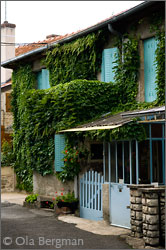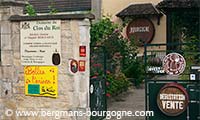
lready in 1855 Dr Lavalle noted, "Like Dijon, Chenôve has gradually lost its vast vineyards". Up here at the northern end of the Côte de Nuits the vignoble has been fighting a losing battle for a long time. In terms of population Dijon is number 18 in France and the only city in Burgundy with more than 50 000 inhabitants. Only since the early 1960's it has increased its population by 15 percent, now counting a total of 155 000. The growth of Dijon has almost entirely erased what was once the viticultural area of Côte Dijonnaise. There are a few small exceptions – Derey Frères in Couchey offers a Bourgogne Montre-Cul and a Clos des Marcs d'Or and René Bouvier in Gevrey-Chambertin offers a Bourgogne Montre-Cul – but most of the vignoble has now been swallowed up by the Dijon suburbs.

Just south of Dijon is where the Côte d'Or village appellations begin. When travelling south towards Nuits-Saint Georges and Beaune the Marsannay appellation is the first one you'll encounter. There are three villages under this appellation – Chenôve, Marsannay-la-Côte (as opposed to Marsannay-le-Bois, north of Dijon) and Couchey.
In 1891, 36 years after Lavalle's book was published, Chenôve counted 812 inhabitants. Today the village has grown considerably, the figure is 15 100, so parts of this area is really the outskirts of Dijon. Chenôve has evolved from a winemaking village to a more modern town, part of Grand Dijon. The old village is still there but as the need for housing in the Dijon area grew in the 1950's Chenôve expanded. The main part of what is left of the vignoble is the Clos du Roy, a large chunk of land – 25 ha 23 a 63 ca – bordering on the commune of Marsannay-la-Côte. Today it is shared between some 15 different owners. In the past when it belonged to the crown it enjoyed a great reputation together with Le Chapitre a bit further north. The latter only enjoys regional appellation status today – Bourgogne Le Chapitre – while Clos du Roy is part of the Marsannay village appellation.

In his "Histoire de Chenôve" Henri Marc tells us that when the Clos du Roy belonged to the French king part of the harvest was destined for the vin cuit, a sweet wine made from white grapes Marc believes came in to production sometime during the 13th or the 14th century. He describes it as a cross between a sweet wine and a vin de Paille. Today the production of vin cuit is long gone in the region, but elsewhere in France, in Provence, you are still able to find some. For vin cuit the grape juice is boiled down before fermentation takes place.
Up behind the village is the Plateau de Chenôve, a 240 ha recreational area that among other things offers tracks for bike riding, walking trails and a view over the village, the Jura and, if the weather allows, Mont Blanc.
Le Jardin Public du Clos du Roy offers orchards, vines and 25 species of farm animals – horses, geese, pigs, donkeys, sheep, goats etc. There is a picnic area and a pond. The park is open all year round, with slight changes to the closing times depending on season.
In Chenôve there is also a market every Wednesday morning (boulevard Bazin) and every Sunday morning (place Coluche and rue Saint-Exupéry).

The RN74 cuts right through Marsannay. When coming from Dijon and Chenôve turn right into Rue de Rocher and you will arrive in the Bourg part of Marsannay. This is where you will find the mairie, the tourist office and the church, the Eglise de l'Assomption which dates back to the first half of the 19th century. Marsannay is a charming village that offers a variety of things to do, both wine-related and not wine-related. Check with the tourist office for information on what is happening at the moment.
Marsannay probably owes its name to a Gallo-Roman, Marcenus, who had a villa here. It first became known as Marceniacum in Monte, then Marcenay-en-Montagne. In 1783 it finally took on its present name - Marsannay-la-Côte.
 In 1855 Lavalle pointed out that the pinot noir had almost completely disappeared from Marsannay. 50 years earlier there had still been considerable amounts of pinot noir planted around the village, but since then the gamay had taken over. In the lieu-dit of Argillières, just north of the village, the last pinot noir vines were uprooted in the 1830's and ten years later the last ones in Recilles, southeast of the village, were gone as well. In 1892 Danguy and Aubertin noted that Marsannay was mainly a village for gamay, but that there were a few winegrowers that had parcels planted with pinot noir.
In 1855 Lavalle pointed out that the pinot noir had almost completely disappeared from Marsannay. 50 years earlier there had still been considerable amounts of pinot noir planted around the village, but since then the gamay had taken over. In the lieu-dit of Argillières, just north of the village, the last pinot noir vines were uprooted in the 1830's and ten years later the last ones in Recilles, southeast of the village, were gone as well. In 1892 Danguy and Aubertin noted that Marsannay was mainly a village for gamay, but that there were a few winegrowers that had parcels planted with pinot noir.
For a long time Marsannay benefited from being close to Dijon. Then in the late 19th century came the railway and the wine from Marsannay, which at the time was made mainly from gamay, suffered stiff competition from the cheaper wines from the south of France. Decline set in and at the beginning of the last century the financial situation for the winemakers in the village had become serious. In an attempt to change things Joseph Clair – grandfather of Bruno Clair of Domaine Bruno Clair and founder of the respected Domaine Clair-Däu - invented the Marsannay Rosé in 1919.

The rosé became popular in Dijon, the producers had changed from gamay to pinot noir and for some time they enjoyed success. But when the appellations were handed out in the 1930's Marsannay was passed by. Stuck with simple Bourgogne and not entitled to use Cotes de Nuits-Villages Marsannay was once again hit by decline. During the following five decades the area under production sank to a mere 19 ha. It wasn't until 1987 that the growers' efforts paid off and Marsannay got an appellation of its own. Bourgogne Marsannay and Bourgogne Rosé Marsannay were then changed to Marsannay and Marsannay Rosé, and things started to look brighter. Today 532 hectares are under vines in the Marsannay appellation and it is the reds, made from pinot noir, that are the big sellers. Rosé accounts for about 20 percent of the production. It is slightly tougher than their Mediterranean counterparts, and is an excellent companion with food. In my view it deserves to be more popular. Domaine René Bouvier in Gevrey-Chambertin makes a lovely Marsannay Rosé and there are several others growers that make equally good rosés. It is of course first and foremost a summer drink, but with the right food to go with it I think it works splendidly all year round.
Most of the grapes for the Marsannay Rosé are grown below the Route des Grands Crus, out towards the RD74 road. Upslope the land is used mainly for the reds and the whites. The same applies for Couchey where the Marsannay appellation continues to the south.
Couchey is considerably smaller than both Chenôve and Marsannay-la-Côte and one of the oldest villages on the Côte. In 409 it was completely destroyed by barbarians. It was mentioned as Copiacus back in 801, then as Cochiacum around 1100, and finally Couchey in 1366. The church of Couchey, l'eglise de St Germain, dates back to the late 15th century and has paintings by Maurice Utrillo..
© 2013 Ola Bergman













